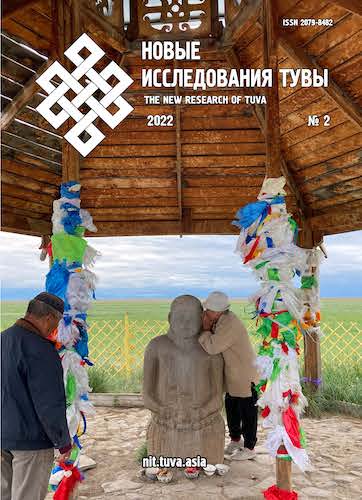A new look at the old fortress: Using remote sensing data in the study of fortified sites in Tuva
DOI:
https://doi.org/10.25178/nit.2022.2.11Keywords:
Tuva; medieval fortress; Shagonar III; remote sensing; aerial surveying; 3D modeling; Uighur Khaganate; Khitan Liao empireAbstract
The article examines the capabilities that remote sensing data can offer for the study of medieval fortifications in Tuva. Our case in point is the Shagonar III site in Ulug-Khem rayon. Previous measurings of the site were largely corrected and improved in 2020, when we aerosurveyed the area with the help of Phantom 4 Pro UAV.
Comparing the processed data with the archeological description made by L. R. Kyzlasov shows that the overall size and square of the site and its internal citadel has not been measured correctly. The same is true for the number of its defensive towers and ditches, and similar mistakes have been made when measuring the neighboring site of Shagonar IV. A search for any counterpart of Shagonar III, a square-shaped fortress with an internal citadel, led us to considering Mongol forts of the Khitan Liao empire which existed from 907 to 1125 CE. The current dating of Shagonar III as built during the Uighur Khaganate thus can be wrong.
The article brings up the issue of the prospects of future aerial surveying and 3D modeling of other fortresses in Tuva, since in their cases corrections of their sizes and architectural details can also be expected. We also conclude that new studies are needed in order to improve absolute chronology of Tuvan fortress sites.
References
Weinstein, S. I. (1964) Drevnii Por-Bazhin [Por-Bazhin of Old]. Sovetskaia etnografiia, no. 6, pp. 103–114. (In Russ.).
Vasiutin, S. A. (2011) Uigurskii kaganat –– tsivilizatsionnaia al'ternativa pastoral'nym imperiiam Tsentral'noi Azii I tys. n. e. [Uighur Khaganate as a civilizational alternative to the pastoral empires of Central Asia in 1st millennium AD]. Vestnik Tomskogo gosudarstvennogo pedagogicheskogo universiteta, no. 11 (113), pp. 28–34. (In Russ.).
Velikaia kidan'skaia stena: Severo-vostochnyi val Chingis-khana [The Great Khitan Wall: The North-eastern rampart of Genghis Khan] (2019) / N. N. Kradin, A. V. Kharinskii, S. D. Prokopets, A. L. Ivliev, E. V. Kovychev and L. Erdenebold; ed. by N.N. Kradin. Moscow, Nauka, Vostochnaia literatura. 168 p. (In Russ.).
Drobyshev, Yu. I. (2009) Uigurskii kaganat –– netipichnaia kochevaia imperiia [The Uighur Khaganate as an atypical nomadic empire]. Vostok (Oriens), no. 3, pp. 17–26. (In Russ.).
Klements, D. A. (1895) Arkheologicheskii dnevnik poezdki v Sredniuiu Mongoliiu v 1891 g. [An archaeological diary of a trip to Central Mongolia in 1891]. In: Sbornik trudov Orkhonskoi ekspeditsii. St. Petersburg, Tipografiia Imperatrskoi Akademii Nauk. Vol. II. 78 p. Pp. 48–59. (In Russ.).
Kyzlasov, L. R. (1969) Istoriia Tuvy v srednie veka [History of Tuva in the Middle Ages]. Moscow, MGU. 212 p. (In Russ.).
Kyzlasov, L. R. (1979) Drevniaia Tuva (ot paleolita do IX v.) [Ancient Tuva from the Paleolithic to 9th century]. Moscow, MGU. 208 p. (In Russ.).
Sadykov, T. R. (2020) Vozmozhnosti polucheniia dopolnitel'noi informatsii iz davno issledovannykh pamiatnikov na dne Tuvinskogo moria [Capabilities of retrieving additional information from sites previously investigated on the bottom of the Tuva Sea]. Arkheologicheskie vesti, no. 26, pp. 248–259. (In Russ.).
Tulush, D. K. (2011) Srednevekovye gorodishcha-kreposti Tuvy [The medieval fortress sites in Tuva]. Vestnik KemGU, no. 2 (46), pp. 39–44. (In Russ.).
Tulush, D. K. (2016) Fortifikatsionnye sooruzheniia Tuvy v kontekste istorii tsentral'noaziatskogo regiona [Fortifications in Tuva in the context of the history of Central Asia]. Oikumena. Regionovedcheskie issledovaniia, no. 4 (39), pp. 107–113. (In Russ.).
Tulush, D. K. (2019) Perspektivy ispol'zovaniia arkheologicheskikh pamiatnikov fortifikatsionnogo tipa v kachestve muzeev pod otkrytym nebom (na primere Respubliki Tyva) [The prospects of using medieval fortification sites as open-air museums: the case of the Republic of Tyva)]. Vestnik Buriatskogo nauchnogo tsentra Sibirskogo otdeleniia Rossiiskoi akademii nauk, no. 2 (34), pp. 168–176. (In Russ.).
Tulush, D. K. (2020) Drevnie goroda Tuvy [Old cities of Tuva]. Novosibirsk, Arsenal. 162 p. (In Russ.).
Khudiakov, Iu. S. (1999) K voprosu ob ukreplennykh poseleniiakh i oboronitel'nykh sooruzheniiakh v Yuzhnoi Sibiri [On fortified settlements and defensive constructions in southern Siberia]. Kuznetskaia starina, no. 4, pp. 104–119. (In Russ.).
Shchetenko, A. Ya. (1983) Raskopki srednevekovogo gorodishcha Bazhyn-Alaak [Excavations of the medieval settlement of Bazhyn-Alaak]. In: Drevnie kul'tury evraziiskikh stepei (po materialam arkheologicheskikh rabot na novostroikakh) [Ancient cultures of the Eurasian steppes: excavated in archaeological works on redevelopment sites] / ed. by V. M. Masson. Leningrad, s. n. 113 p. Pp. 45–47. (In Russ.).
Shelach-Lavi, G., Wachtel, I., Golan, D., Batzorig, O., Amartuvshin, C., Ellenblum, R. and Honeychurch, W. (2020) Medieval long-wall construction on the Mongolian Steppe during the eleventh to thirteenth centuries AD. Antiquity, no. 94 (375), pp. 724–741. DOI: https://doi.org/10.15184/aqy.2020.51
Vavulin, M. V., Chugunov, K. V., Zaitceva, O. V., Vodyasov, E. V. and Pushkarev, A. A. (2021) UAV-based photogrammetry: Assessing the application potential and effectiveness for archaeological monitoring and surveying in the research on the ‘valley of the kings’ (Tuva, Russia). Digital Applications in Archaeology and Cultural Heritage, vol. 20, e00172. https://doi.org/10.1016/j.daach.2021.e00172
Published
How to Cite
For citation:
Vodyasov Ye. V. and Zaytseva O. V. Novyi vzgliad na staruiu krepost’: ispol’zovanie dannykh distantsionnogo zondirovaniia dlia izucheniia fortifikatsionnykh sooruzhenii Tuvy [A new look at the old fortress: Using remote sensing data in the study of fortified sites in Tuva]. New Research of Tuva, 2022, no. 2, pp. 167-176. (In Russ.). DOI: https://www.doi.org/10.25178/nit.2022.2.11
Issue
Section
Copyright (c) 2022 Журнал "Новые исследования Тувы" (составление)

This work is licensed under a Creative Commons Attribution-NonCommercial 4.0 International License.

Author(s) license holder(s) grant rights for their work to the journal (grantee of a license) under the simple non-exclusive open license in accordance with Art. 1286.1 «Open license for a research work, work of literature or fine arts», Civil Code of the Russian Federation.
New Research of Tuva publishes articles under the Creative Commons Attribution-NonCommercial license (CC BY-NC).
Since it is an open license, author(s) reserve the right to upload the article to their institutional repository, submit it to another journal (if it allows republications), or republish it on their own website (in full, or in part).
However, several conditions apply here:
a) The republished version must always contain the name(s) and affiliation(s) of the author(s), the original title and the hyperlink to the original version on the New Research of Tuva website;
b) It must be in open access, free of charge, and no category of readers must be in any way whatsoever advantaged over general readership.
c) should the contribution be submitted elsewhere by its author(s) without substantial modification (30% or more of original text unchanged), the body of the article should contain a disclaimer that the original version was published in New Research of Tuva (with a link to the respective page)
The CC-BY-NC is a non-revocable license which applies worldwide and lasts for the duration of the work’s copyright.










